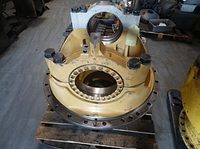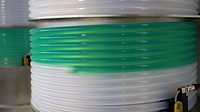Industry Coming Together to Battle a Hidden Threat
Combatting the Hidden CUI Threat in The Energy Sector

Image credit: Gard Reian, Jotun.
Corrosion under insulation (CUI) is a longstanding issue for energy facilities, persisting as long as steel equipment has had insulation. Moisture infiltrates insulation due to condensation or external sources, creating optimal conditions for corrosion when combined with high or fluctuating temperatures.
The Norwegian Petroleum Safety Authority reports that over 20% of major oil and gas accidents within the EU since 1984 have been linked to CUI. Furthermore, approximately 50% of reported hydrocarbon leaks at onshore plants in that study are attributed to CUI.1 This indicates the challenge CUI presents to facilities aiming to reduce risks and hazards.
Explaining the issue from a technical perspective, Svein Jacob Kaspersen, R&D manager for specialty temp and tank at Jotun Performance Coatings, says, “Standard carbon steel can be affected when moisture infiltrates insulation from sources like precipitation or condensation during cyclical processes, or when stable systems are shut down for maintenance. Stainless steels can suffer external chloride-induced stress corrosion if contaminants, such as chlorides from the atmosphere or insulation, reach the steel surface. Therefore, coatings are typically applied to protect steel structures under insulation from corrosion-related damage throughout the equipment's operational life.”
While CUI is not a new issue, it has received increased focus over the last 50 years. “One reason it has gained importance is because operators now emphasize energy efficiency, which can drive the need for insulation,” Kaspersen said.
Insulation is also essential for maintaining steady temperatures in various refinery processes. "This can require cool or cryogenic temperatures, as well as high temperatures," Kaspersen continues.
A Hidden Threat
Despite increased industry attention, there’s no quick fix for CUI. One major challenge is that CUI is difficult to detect due to the layers involved. During processes, steel expands and contracts with temperature changes, but the protective coating may expand and contract at a different rate. This can stress the coating, potentially leading to cracking or flaking that leaves steel unprotected. High temperatures can also degrade the coating.
“For uninsulated pipes, this degradation would be visible during routine inspections. However, once insulation surrounds the pipe, any damage becomes invisible. There may be signs in extreme cases, like staining or lifting of the insulation, but this isn’t reliable. Furthermore, in exposed situations, the insulation requires protection from the elements, so it has an outer jacket or casing,” Kaspersen explains.
Manufacturers of piping, coatings, insulation and casings have worked independently to develop products to reduce CUI. However, there has been limited collaboration among these parties.
Working Together to Solve the Problem
This state of affairs existed until 2018 when an ISO standard for testing coatings was published. In 2018, an ISO standard for testing coatings, ISO 19277 (https://www.iso.org/), was published. While a step forward, its mandatory elements did not test coatings together with insulation.
That same year, a Joint Industry Project (JIP) began in the U.S., with phase one concluding in 2023. Coordinated by Southwest Research Institute (SwRI) in San Antonio, Texas, the project aimed to assess the durability of various coatings and insulation types for CUI. Participants included eight oil and gas operators, five coating manufacturers (including Jotun) and several insulation suppliers.
“I’m delighted that, after years of collaboration, we’ve established a new and improved test method for coating and insulation systems. While CUI has gained attention in recent years, in-depth research has been limited, making this JIP a major asset for the industry,” said Leonardo Caseres, principal engineer, materials engineering department at SwRI.
He continued, “This project took a systematic approach, examining how different coatings and insulation systems perform together—reflecting real-world scenarios. Insights from coating and insulation manufacturers, along with real-life performance data from end users, were invaluable. Collaborations like this are essential to deepen knowledge on complex topics like CUI, and this advancement will help develop new coatings and insulation products.”
The new standard test procedure has been published by the Association for Materials Protection and Performance (AMPP) as AMPP TM21442 (https://store.ampp.org/).
The AMPP document notes, “CUI test methods currently available in the industry do not mimic field conditions. This AMPP standard provides a comprehensive test methodology to simulate field conditions under insulation to establish the performance of a coating in service.”
During the SwRI JIP, coated pipe spools with different types of insulation were subjected to wet and dry testing with temperature cycles ranging from 21 °C to 80 °C and from 21 °C to 315 °C. Products from Jotun’s Jotatemp range demonstrated strong overall performance.
Commenting on Jotun’s role in the SwRI JIP, Ingrid Vee, global category manager for heat resistance at Jotun, says, “We are proud to have contributed to the development of this new industry standard by sharing research expertise and experience.”
A 2021 study by DNV for the Norwegian Petroleum Institute found that operators consider CUI “the biggest threat to the mechanical integrity of oil and gas industry facilities.”* Understandably, this issue is now a high priority in the industry, as failure of any steel component in an energy plant could endanger nearby workers and the surrounding area.
Ultimately, it all comes down to protecting assets and properties effectively.
1 Norwegian Petroleum Safety Authority. "Maintenance Management: Corrosion Under Insulation." Havtil.no. 2022. https://www.havtil.no/contentassets/9ec16fd263fc4a25a5b8e4fc20de33d3/maintenance-manegement---corrosion-under-insulationLooking for a reprint of this article?
From high-res PDFs to custom plaques, order your copy today!






